
While most Americans spent Wednesday with their attention focused on the New Hampshire primaries, in hope of the 2008 presidential election, the current president was continuing the travesty that is his presidency.
 Reminiscent of the Gulf of Tonkin incident that was used to begin action in Vietnam, US government official claims are reported as absolute truths.
Reminiscent of the Gulf of Tonkin incident that was used to begin action in Vietnam, US government official claims are reported as absolute truths.
During the Gulf of Tonkin incident the official story sold to the American people was that the North Vietnamese torpedo boats launched an “unprovoked attack” against a US destroyer on a “routine patrol.”
Sound familiar?
Here is what the LA Times reported:
A group of small Iranian boats charged and threatened three American warships just outside the Persian Gulf, military officials said Monday, elevating tensions and illustrating how easily a military confrontation could develop between U.S. and Iranian forces. [LA Times]
Another wrote:
According to U.S. military officials, five Iranian boats made hostile moves toward U.S. ships entering the Persian Gulf while threatening to “explode” them. Although the U.S. military has labeled the incident a “significant confrontation,” the Iranian government has characterized it as a routine event. [SF Gate]
NY Times editors warned:
Iran played a reckless and foolish game in the Strait of Hormuz this week that — except for American restraint — could have spun lethally out of control. [NY Times]
According to the World Health Organization at the end of 2005 there were 5.7 million adults and children living with HIV/AIDS in India with a population of approximately 1.1 billion. India is the second largest country behind South Africa with the highest number of HIV/AIDS patients.  In India, Mumbai is generally viewed as the Indian city with the most HIV/AIDS patients. However, the state of Punjab is not immune to the epidemic, even though the numbers are relatively small compared to major urban centers such as Mumbai. Numbers aside, the primary source of transmission of the HIV/AIDS within and outside of Punjab is heterosexual intercourse and intravenous drug use. Prof. Sehgal S. of the Department of Immunopathology, Postgraduate Institute of Medical Education and Research, Chandigarh states, that 80.5% of HIV/AIDS patients contracted the virus heterosexually in Punjab, while India’s National AIDS Control Organization (NACO) believes that “the bulk of HIV infections in India occur during unprotected heterosexual intercourse”. Furthermore, the International Women’s Health Coalition cites that one of the highest risk factors for women contracting HIV/AIDS is marriage with 4/5 of new infections in women resulting from having a sexual relationship with their husband. Hence, women, particularly, those in rural areas are one of the fastest growing populations of HIV/AIDS patients in India as well as other countries. A CBS News report states that for Dr. Solomon, 90% of “female patients [at his AIDS hospital in Madras] are not prostitutes, but monogamous women who’ve contracted HIV from their husbands”. Many of these women are like Periasamy Kousalya “… whose husband from an arranged marriage was a trucker. He had HIV before they got married”.
In India, Mumbai is generally viewed as the Indian city with the most HIV/AIDS patients. However, the state of Punjab is not immune to the epidemic, even though the numbers are relatively small compared to major urban centers such as Mumbai. Numbers aside, the primary source of transmission of the HIV/AIDS within and outside of Punjab is heterosexual intercourse and intravenous drug use. Prof. Sehgal S. of the Department of Immunopathology, Postgraduate Institute of Medical Education and Research, Chandigarh states, that 80.5% of HIV/AIDS patients contracted the virus heterosexually in Punjab, while India’s National AIDS Control Organization (NACO) believes that “the bulk of HIV infections in India occur during unprotected heterosexual intercourse”. Furthermore, the International Women’s Health Coalition cites that one of the highest risk factors for women contracting HIV/AIDS is marriage with 4/5 of new infections in women resulting from having a sexual relationship with their husband. Hence, women, particularly, those in rural areas are one of the fastest growing populations of HIV/AIDS patients in India as well as other countries. A CBS News report states that for Dr. Solomon, 90% of “female patients [at his AIDS hospital in Madras] are not prostitutes, but monogamous women who’ve contracted HIV from their husbands”. Many of these women are like Periasamy Kousalya “… whose husband from an arranged marriage was a trucker. He had HIV before they got married”.
I just saw this post on Sepia Mutiny on Ruby Dhalla’s recent trip to Punjab. As previously blogged by Anandica, Dhalla, the Canadian MP of the Brampton, was there to attend the Punjabi NRI Sammelan. It seems one of her staffers had her bag snatched in the village Pohir. Dhalla was in the village to speak at the SDP College for Women. Encouraging women to reach for their dreams, she saw the nightmare that is the Punjab Police.
Their tender age didn’t stop Punjab police from thrashing them mercilessly,” the Times of London wrote. “The kids begged and pleaded for mercy but the cops didn’t relent: they kept raining blows on them.
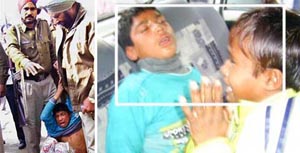 Although this blog is still very young, I am sure future blogs will continue to impunity in which the Punjab Police functions. Earlier this week we read of the prison rebellion after the Punjab Police prison officials forcibly cut a Sikh inmate’s hair.
Although this blog is still very young, I am sure future blogs will continue to impunity in which the Punjab Police functions. Earlier this week we read of the prison rebellion after the Punjab Police prison officials forcibly cut a Sikh inmate’s hair.
Although a popular joke in the Punjab, unfortunately it speaks of its realities.
The CIA, UK’s Scotland Yard, and Punjab Police all try to prove that they are the best at apprehending criminals.
They decide to have a competition. A lion is released into a forest then the police agency will go out to capture it. The police agency that succeeds in the least time will be the winner.
The CIA goes first. They place animal informants throughout the forest. They question all plant and mineral witnesses. After 1 hour of extensive investigations they catch the lion.
Next it is the turn of Scotland Yard. Following tracks and examining changes in the foliage, they are able to capture the lion in 45 minutes.
Finally, it is the turn of the Punjab Police. Hours go by and the judges get no response. Deciding to check on the Punjab Police, the judges venture into the forest. There they see a donkey hung upside by its hind legs. A Punjab Police Officer (probably KPS Gill) is lashing the donkey with an iron rod, screaming “Bol thu sher hai” (“Say/Admit you are a lion!”).
Economic development and investment opportunities in Punjab were discussed at the Punjab NRI Sammelan, in Chandigarh and Jalandar, on January 5th and 6th. This brings about an important topic of maintaining our heritage and the significance of NRIs giving back to their communities in Punjab. There was a time when NRIs were investing their money made overseas by going back to their village and building a big haveli with a huge artificial plane sticking out of the roof (so they, and everyone else, could see their house when flying over their village!). Thankfully something positive, and more meaningful, is being asked of Punjabis overseas. We are all fully aware of the lack of employment opportunities, education and healthcare and how these issues have created dire consequences of drug-use and alcohol abuse. The conference was attended by prominent NRI’s including Dr. Ruby Dhalla, M.P. from Canada; Ms. Neena Gill, Member of EV Parliament in Brussels; and Mr. Varinder Sharma, former Major of London and Member of Parliament UK. The purpose of the conference was to present initiatives Punjab Chief Minister Badal, and his committee have created as improvements needed to increase the efficiency of Punjab’s infrastructure. 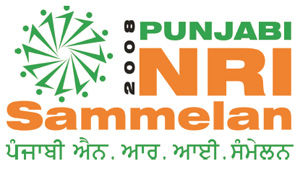 The goal of this conference is to attract technical and financial investments from NRIs. The attendees were given the opportunity to voice their opinions of what they felt should be noted as additional initiatives concerning the NRIs continuing financial support in future projects. One such request has been validated with the creation of an eleven member Advisory Committee to preside over issues related to the welfare of NRIs investments.
The goal of this conference is to attract technical and financial investments from NRIs. The attendees were given the opportunity to voice their opinions of what they felt should be noted as additional initiatives concerning the NRIs continuing financial support in future projects. One such request has been validated with the creation of an eleven member Advisory Committee to preside over issues related to the welfare of NRIs investments.
During the conference a British NRI pledged Rs. 5 million for the renovation and upkeep of a state-run school in his village, which was met by an equal pledge from the Chief Minister. Hopefully this action will encourage other individuals to follow suit, especially considering Sikhi teaches us values to help others less fortunate than ourselves and strive to create equality amongst people. Education is a key element in creating a sense of pride back into our Punjab, and a little can go a long way. I applaud this conference and hope we will hear and see more positive consequences from it. There is the likelihood of some negativity, such as the incident of Deepak Obhrai, the highest-ranking Indo-Canadian in the present government, being ignored by the Punjabi government. He feels he was excluded due to being “Hindu Punjabi” and not “Sikh Punjabi”. This does not bode well for us, especially when the purpose of this conference is to gain support from ALL Punjabis, and that we should be striving for equality. Differences need to be put aside for the selfless purpose of improving Punjab and allowing the people of Punjab to reach their true potential. Hopefully that purpose will be achieved successfully, and we can finally make a difference.
 This morning 1500 prisoners in a Jalandhar jail rebelled due to the attack by prison guards on the Sikh religious icons. Initial reports seem to indicate that the guards forcibly cut the hair of the Sikh inmate and others had prisoners had been pressured to cut their hair as well. The acting superintendent alleges that the cutting of the hair was a ‘concocted’ story, but widespread abuse by the Punjab Police seems to give little credence to his comments. Such rebellions were common during the British Raj and it seems the zulm (injustice) continues.
This morning 1500 prisoners in a Jalandhar jail rebelled due to the attack by prison guards on the Sikh religious icons. Initial reports seem to indicate that the guards forcibly cut the hair of the Sikh inmate and others had prisoners had been pressured to cut their hair as well. The acting superintendent alleges that the cutting of the hair was a ‘concocted’ story, but widespread abuse by the Punjab Police seems to give little credence to his comments. Such rebellions were common during the British Raj and it seems the zulm (injustice) continues.
The rebellion became violent as maltreatment, lack of justice, and deteriorating medical and food provisions had been grievances. BBC News has reported on the story and more reports seem to filtering in. More updates soon.
This article didn’t sit well with me. While the author tries to maintain some sort of ‘objective’ tone to voice the ‘ambiguities,’ it all read as a surreal story of perverted neo-colonialism and dominant commodification.
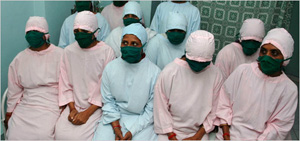 The NY Times author writes about the spread of a ‘surrogate mother industry’ in India. Whereas surrogacy in America can cost upwards to $80,000, globalized outsourcing cuts the cost to a mere $5000 in India. This fast-growing $445-million-a-year business is extremely lucrative. However, I can’t understand the ethics.
The NY Times author writes about the spread of a ‘surrogate mother industry’ in India. Whereas surrogacy in America can cost upwards to $80,000, globalized outsourcing cuts the cost to a mere $5000 in India. This fast-growing $445-million-a-year business is extremely lucrative. However, I can’t understand the ethics.
Listening to the NPR piece, the sense of entitlement the American “Julie” borders on the absurd. She languishes that American surrogates may be “smoking, drinking alcohol, doing drugs…no one policing her in the sense that you don’t know what’s going on.” For “Julie” she prefers India where surrogate women are ‘stored’ in a “clinic or one of the supervised homes, making it easier to monitor diet and health. This kind of control just wouldn’t be possible in the States, says Julie.”
The author believes that leasing wombs can be ‘empowering.’ For individual women this may be the case when faced with abject poverty. India’s poverty is brutal. Thus I pass no judgment on the poor rural women. However I MUST condemn the institutional hierarchies and poverty that makes such global inequality possible. For me, there can be no hesitancy or ‘ambiguity.’ Such practices occur because of the conditions that make people sell their kidneys in India. This only furthers the problem of ‘commodification’ of women in that their womb is nothing more than a ‘money-maker.’ Does this lead to greater violence towards women? The effects of the commodification of women have already been discussed on this young blog. Global inequality must be condemned in the strongest terms. There is no moral relativism. Where there is such disparate global inequality, we have global injustice.
Recently I have read a few articles about instances where Sikh leaders have partaken in activities with various anti-Sikh groups, such as the RSS and Dera Sacha Sauda.
In part, the controversies that have arisen are rooted in the questions of what role Sikh leader ought to play in the context of anti-Sikh propaganda. Should our leaders be attending functions organized by anti-Sikh groups? Should they boycott them? Many leaders have been seen “supporting” such organizations by hobnobbing with, accepting gifts from, and turning a blind eye to their activities.
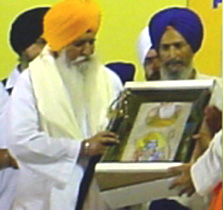
One recent instance of this is the Jathedar of the Akal Takht and others accepting pictures which expressly co-mingle Sikhi with Hinduism (with Guru Nanak Dev Ji and Sri Ram) at an RSS function. It may not seem like a big deal, but one of the RSS’s assertions is that Sikhs are derivatives of Hinduism and that the Guru’s are the descendants of the Hindu God Ram. I wonder if anyone else feels that our Jathedar’s acceptance of such a picture is a bit shady? As a Sikh I expect my leaders to stand up for Sikh beliefs and the Sikh identity – not accept memorabilia which dilutes my identity and depicts something that they sit on stages across the globe and negate.
As I write this post, I realize that some of you may be thinking that of the instance above does not amount to much, but I think it is illustrative of a much larger issue …if our leaders do not take a stand on something as simple as “Sikhi and Hinduism are not the same,” then where does that leave us as a Sikh nation? How are we to face other challenges to our identity in the West? What are our expectations of our leaders? And are there any avenues we can take to enact change?
Veerharinder Singh and Pawanjot Kaur were married on November 1, 2001. Apparently this ill-fated relationship started off on the wrong foot.
Veerharinder had said he was a graduate owning gas stations. He turned out to be class 12 pass and an employee in a factory. Pawanjot was B.Sc medical.
Veerharinder then left for Surrey, abandoning his bride in Punjab.
Ranphool (Pawanjot’s father) claimed the man and his family were all good till they gave wrong information to the embassy that had rejected the papers of my daughter to emigrate to Canada.
As if abandoning the bride wasn’t enough: Veerharinder demanded 30 lakh (a mere $75,000!) for dowry, and his father was camped out in Punjab, waiting to receive this from Pawanjot’s family.
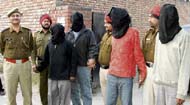 Pawanjot came to Canada on her own and stayed with her grandfather in Edmonton when Veerinder’s family rejected her. Then, the plot thickens… Veerharinder tried to teach his father-in-law a lesson for sending Pawanjot to Canada.
Pawanjot came to Canada on her own and stayed with her grandfather in Edmonton when Veerinder’s family rejected her. Then, the plot thickens… Veerharinder tried to teach his father-in-law a lesson for sending Pawanjot to Canada.
Police charges allege that the husband and his cousin hired a group of contract killers for 120,000 rupees (about $3,000) after the father of the bride could not raise the dowry for his daughter.
Luckily the killers were amateurs discussing their plan at a dhaba … where they were overheard and reported to the police.
Veerharinder, how do you face yourself in the mirror?
 As we celebrate the New Year and look forward to what it holds in store for us (at the very least an election!), it is important to look back and remember what we have experienced as a community this past year. In celebration of the Sikh Diaspora and what it represents to us today, here is a look back at some of the global stories, books, films and websites that impacted our community in 2007.
As we celebrate the New Year and look forward to what it holds in store for us (at the very least an election!), it is important to look back and remember what we have experienced as a community this past year. In celebration of the Sikh Diaspora and what it represents to us today, here is a look back at some of the global stories, books, films and websites that impacted our community in 2007.
- Young Sikh Men Get Haircuts, Annoying Their Elders. “It’s usually college-going students who are more worried about looking good than about their spiritual identity…[It] releases a certain amount of pressure.”
- A new website, Sikh Chic, discussing articles related to the art and culture of the Sikh Diaspora was launched. “We need to re-think the Sikh idea in the North American idiom, in our language, in our way of articulating our thoughts.”
- The Sikh clergy issues an edict directing the Sikh Sangat to snap all ties, including social, religious and political, with Baba Ram Rahim Gurmit, head, Dera Sacha Sauda, and its followers.
- Several books for and about Sikhs are published and discussed including Shame, Sacred Games, Sikhs in Britain, Londonstani, Sikhs Unlimited, I See No Stranger: Early Sikh Art and Devotion.
- A Sikh-Canadian group slams the long-standing immigration policy that forces people with the surname Singh or Kaur to change their last names. It was later noted that the immigration letter sent out was poorly worded.
So Modi and the BJP win again. Kill 2,000 Muslims and become Chief Minister. Hardly new. Kill 3,000 Sikhs and become Minister for Overseas Indian Affairs.
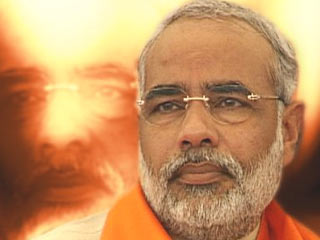 Reasons for Modi’s victory will soon flow: his cult of personality, the use of xenophobic propaganda against “jihadis” (Read: Muslims), the reaction against the anti-Modi media, slogans of development success and Gujarat’s economic boom in the last few years. While the majority in Gujarat will celebrate their victory, I am left wondering.
Reasons for Modi’s victory will soon flow: his cult of personality, the use of xenophobic propaganda against “jihadis” (Read: Muslims), the reaction against the anti-Modi media, slogans of development success and Gujarat’s economic boom in the last few years. While the majority in Gujarat will celebrate their victory, I am left wondering.
Does development trump human rights?
Modi is no longer a Gujarati politician. He is an international Indian star. Nowhere is his popularity as strong as that which he receives from the Patels and NRIs in America. While some assumed the Congress victory in 2004 was a turning point in the electorate, the sheer popularity of Modi’s brand of Hindutva has made him a national level politician. That Sonia Gandhi had to directly intervene to challenge Modi and then to fail will catapult Modi’s stock. He is Hindutva’s celebrity.
The Congress Party’s history and rhetoric offers few opportunities for ambitious political elites. In the new India it is Hindutva that represents the greatest possibility for change. Modi is this change. He is India.
Gurharpal Singh in his Ethnic Conflict in India: A Case-Study of Punjab made this same prediction eight years ago. He saw two possibilities of the Hindutva end game,
either towards a continental assertion of Hindutva or its contraction to the core.
Either the Hindutva agenda will reign supreme or the periphery regions (Kashmir, Punjab, Nagaland, Assam, etc.) that are not Hindu and can mobilize on non-Hindu icons and culture will look for another alternative.
